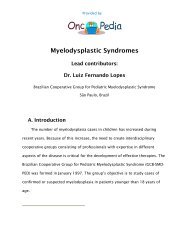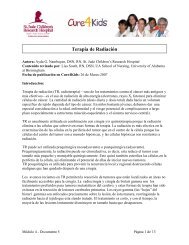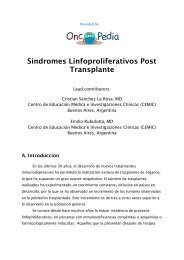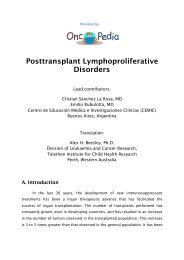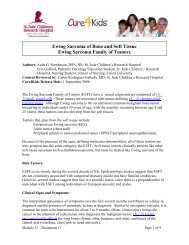Non-rhabdomyosarcoma soft tissue sarcomas (NRSTS)
Non-rhabdomyosarcoma soft tissue sarcomas (NRSTS)
Non-rhabdomyosarcoma soft tissue sarcomas (NRSTS)
You also want an ePaper? Increase the reach of your titles
YUMPU automatically turns print PDFs into web optimized ePapers that Google loves.
<strong>Non</strong>-<strong>rhabdomyosarcoma</strong> <strong>soft</strong> <strong>tissue</strong> tumors (<strong>NRSTS</strong>)<br />
A -5 Intergroup Rhabdomyosarcoma Study Surgicopathologic Staging System<br />
Clinical Group I: Localized disease, completely resected<br />
a. confined to muscle or organ of origin<br />
b. contiguous involvement – infiltration outside the muscle or organ of origin,<br />
as through fascial planes<br />
Clinical Group II: Total gross resection with evidence of regional spread<br />
a. grossly resected tumor with microscopic residual disease<br />
b. regional disease with involved nodes, completely resected with no<br />
microscopic residual<br />
c. regional disease with involved nodes, grossly resected, but with evidence of<br />
microscopic residual and/or histologic involvement of the most distal regional<br />
node (from the primary site) in the dissection.<br />
Clinical Group III: Incomplete resection with gross residual disease<br />
a, after biopsy only<br />
b. after gross major resection of the primary (>50%)<br />
Clinical Group IV: distant metastatic disease present at onset<br />
Lung, liver, bones, bone marrow, brain and distant muscle and nodes. The presence<br />
of positive cytology in the cerebrospinal, pleural or abdominal fluids, as well as<br />
implants on pleural or peritoneal surfaces, are regarded as indications for<br />
categorizing the patients in this group.<br />
Go Back<br />
Module 13 - Document 22 Page 10 of 12



